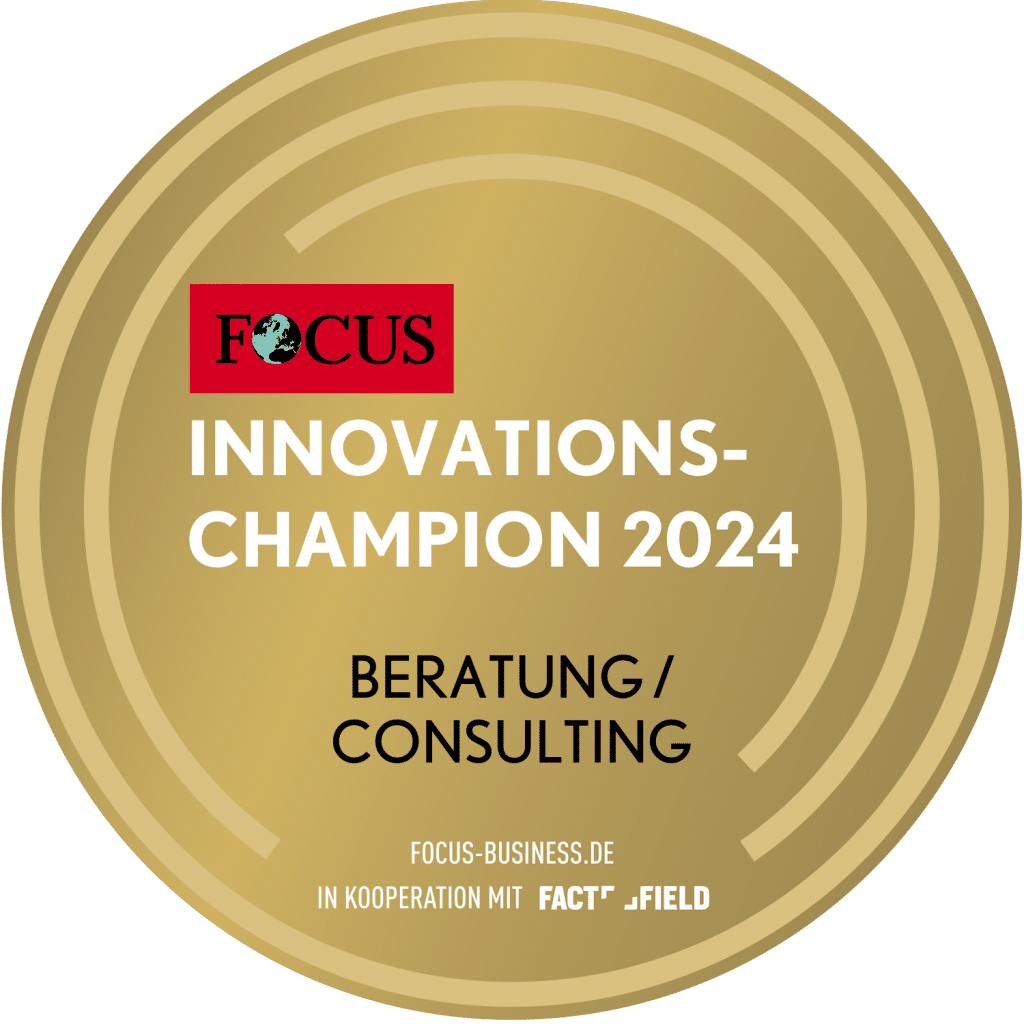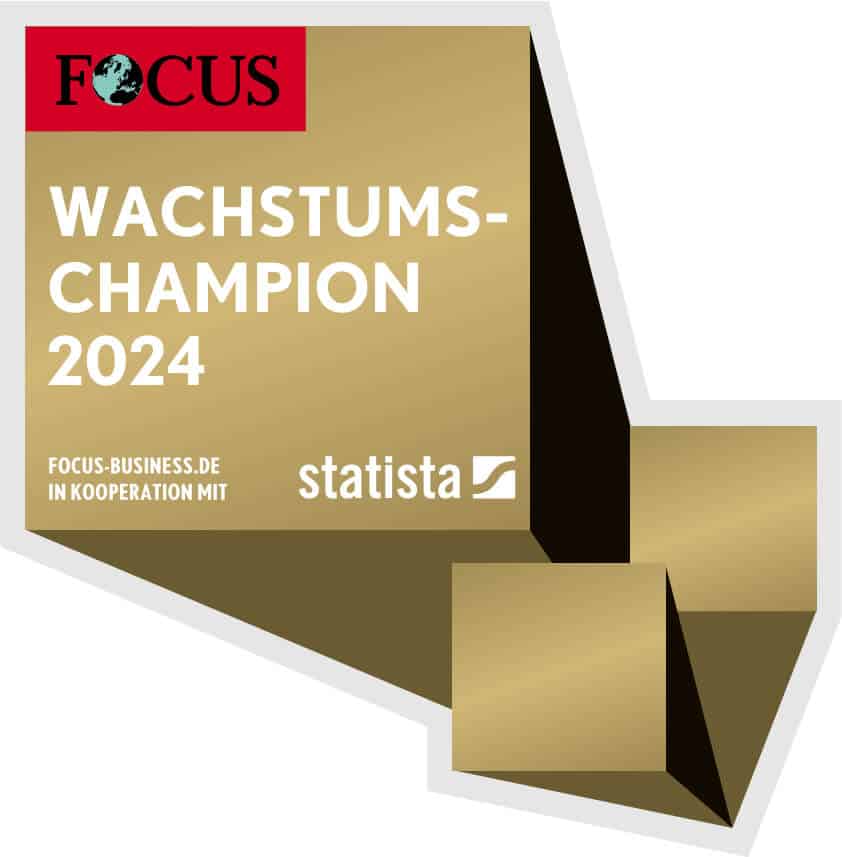Are you one of those companies that know your customers' journey with all touchpoints? Do you also know at which touchpoint of the customer journey potential customers drop out, often because of a single negative experience? Read this article and learn how to identify, analyze and proactively model all touchpoints of the customer journey so that your customer remains a customer and talks positively about you. Because only with a customer-centric outside-in mindset will you inspire and retain loyal customers in the long term.
Please also read our blog post on customer centricity and customer experience: What customer-centric thinking and acting really means. Furthermore, the authors offer Free webinars on the topic to.
Why every company should know the details of its customers' journey
Negative shopping experiences, such as abandoned purchases, account for a potential loss of sales of up to €2.2 trillion annually.
~ Adyen Global Retail Report, 2019.
Depending on the industry and sales channel, up to 19 out of 20 potential customers drop out before making a purchase decision. There is a reason for every drop-off. And this cause is often due to a single negative experience that the customer had at one of their points of contact with you. The point of contact and the cause often remain undiscovered for you. Only if you know all the points of contact and know what expectations and needs, what questions and thoughts, what feelings and emotions the customer has at these points, only then will you be able to identify and minimize the causes of a drop-off.
The tool and process of customer journey mapping is not really new. Nevertheless, the conversion rates of most companies are poor. And yet many companies waste their resources on internal issues and fail to take a consistent outside-in, customer-centric perspective on what ultimately matters: meeting real customer expectations holistically across all touchpoints of the customer journey. In this article, we therefore describe how you can
- Make your customers' journey transparent for you
- ensure that the customer continues their journey with you.
We will show you ways to ensure that your customers remain customers and speak well of you as a supplier and recommend you - from the first to the last point of contact with you. Because we want to help you to ensure that your customer not only remains a customer, but becomes your long-term fan!
The customer journey
Where does a customer start to gain experience with a supplier? Right from the first contact that the customer has with the potential supplier. This starting point is often not recognized and taken up. For many manufacturers - especially in the SME B2B environment - the customer journey only begins after delivery and installation. They neglect the many touchpoints that a customer has from initial attention to the purchase decision and ignore their poor conversion rate from initial contact to sale. Other companies focus primarily on the marketing component of customer experience: How do I use customer experience to increase my sales? However, this is the total inside-out view, which runs counter to the idea of customer experience.
The customer journey therefore describes the customer's journey consistently and exclusively from the customer's perspective (outside-in or from the outside in). This journey starts with the very first contact that the potential customer has with the company - a touchpoint that often takes place without the company's knowledge.
The goal should be that a customer's journey never ends, that this customer remains loyal after his first purchase decision and buys again and again. And the goal should be that this customer attracts new customers by talking well about you as a supplier, well about your company, your products and services and your employees. However, this only works if companies start to take the customer's point of view and recognize and meet their needs and expectations in a customer-centric way.
Milestones and phases of the customer journey
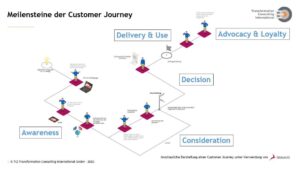
It is important to understand the significance of the customer journey in its entirety with all touchpoints for creating a sustainable, positive customer experience. In the following, we therefore describe the customer journey with all milestones and key transitions as an example. Based on the customer's experience at each of the individual touchpoints, the customer (and only the customer) decides whether to continue or abandon the journey. In our picture, the customer journey is depicted using Signavio, a software that allows processes to be visualized very clearly. This digitalization tool can also be used to create links to other tools.
a) Awareness
The customer journey begins with the point of contact at which a customer consciously perceives you as a potential supplier and becomes aware of you. Accordingly, this point and the subsequent first phase of the customer journey are called Attention = Awareness. This first phase of the search is therefore about gaining attention and maintaining and increasing this attention once it has been gained. The special feature of this phase is the lack of visibility of many touchpoints and therefore also the lack of feedback on the experience that a customer has at these invisible touchpoints: the lack of feedback makes this experience difficult to assess. This makes it correspondingly more difficult to define improvement measures.
b) Consideration
The next phase begins with the consideration of shortlisting you as a supplier: Consideration = Consideration. Here it is important that the points of contact are personalized and individualized for your customers. The customer wants and should feel personally addressed by your offers. To achieve this, you must not only identify the expectations at the respective touchpoints, but you must also recognize in detail what will ultimately motivate the customer to make a positive purchase decision. Your approach - and above all your offer - must be tailored to these expectations in terms of content and price. You will gain a decisive competitive advantage if you find out what the customer particularly values and what they lack in your competitors' offers. Therefore, make sure that your offer is unique and that the customer cannot get past you.
c) Decision
The consideration phase will hopefully be completed with the right Decision = Decision. The customer gives you the order. The final details of the purchase and delivery are defined and the contract is concluded. For this milestone, it is important to note that new contact persons are often involved, especially in the B2B environment. The customer journey starts with the customer, the organizational unit or the person who needs the product or service. Others may come on board later, such as purchasing or procurement, scheduling, the legal department and quality. This means that there are a large number of partners who can ensure that even a positive purchasing decision is revised in the event of negative experiences.
d) Delivery & Use
Then follow Delivery and use = Delivery and use. The customer hopefully receives the ordered goods/services and can start using them. The potential risks of unreliable delivery are not sufficiently taken into account, especially in online retail. What happens after the customer presses the order button? The online retailer hands over their goods to a logistics service provider - and this is where a gap begins. The seller has no influence on the performance of the service provider, the customer waits for the goods. We all know how a poor delivery service can ruin what was previously a very good experience. If customers have to chase the delivery of an online seller, they might as well buy from a stationary retailer!
The after-sales service period begins for the supplier after delivery at the latest. Now the customer wants to use or apply the purchased product or generate added value from a service. There are many opportunities for the supplier to leave both positive and negative experiences at the points of contact. Here are a few examples:
- How reliable is the product?
- How proactively is it ensured that the customer can always use their delivery in line with their expectations?
- How quickly and in what way are complaints responded to?
- How easy is it for me as a customer to get in touch with the supplier?
- Does the supplier help me to serve my customers in the best possible way - now and in the future?
- And, and, and...
e) Loyalty & Advocacy
At this point, the next phase is initiated. The phase Loyalty and recommendation = Loyalty and advocacy. This is the phase in which the customer gives feedback and in which he decides whether he will remain loyal and buy from you again. This phase is far too often underestimated by your impact, treated only superficially or not considered at all. This is despite the fact that this phase shows how well a supplier has delivered the promised services and what overall experience they have left behind.
- Was it good enough for the customer to buy again?
- Or was he even so good that he recommends the supplier to others?
But even that is only one side of the coin.
- How does the supplier deal with customer feedback?
- Does it take feedback constructively and take it into account when continuously improving the customer experience?
- And - most importantly - does he thank his customer for the feedback (even if it is negative!) and give feedback on the measures taken?
A closed feedback cycle can lead to customers remaining loyal even in the event of negative experiences. If no feedback is given, this negative experience at the end of the customer journey often leads to the final end of a customer journey.
Persona: essential basis for customer journey mapping
Every analysis of the customer journey must be carried out with a real or representative customer. The customer as a person has expectations and feelings and experiences. To this end, the person is described in detail at the beginning of the "Customer Journey Mapping" exercise. The image of the customer that emerges from the description - the persona - should ensure that everyone can assess what really makes the customer tick - why they behave the way they do! Everyone should see the customer in front of them, and this image should be as identical as possible for all participants in the exercise. This can be a typical customer or a real/known/present customer.
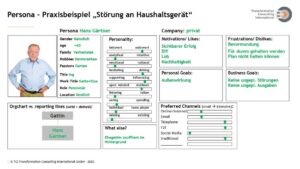
That is why the human being is described here:
- Who he is and what he loves
- The personality
- His position in his company
- What he likes and what drives him
- What he doesn't like
- His personal goals
- His business goals
- Which communication channels he uses
- And what else is available.
When analyzing the customer journey, this persona is placed in the business context, the real and concrete business context.
Analyzing the customer journey
A predetermined part of the entire journey is usually selected for customer journey mapping. For example, the phase or phases that have attracted attention due to frequent complaints or in which high bounce rates have been identified are suitable for this. If the entire journey is to be analyzed, sufficient time must be scheduled. A complete recording of a customer journey with subsequent analysis and definition of improvement measures can easily take a whole week. Even if it is limited to one or two milestones, two to three days should be planned, including the introduction and persona.
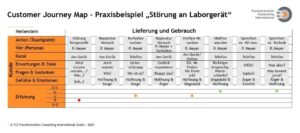
Mapping the journey begins with identifying the touchpoints - this is where the customer's activities are displayed, i.e. the pure customer view! For example: You as the supplier do not call, but the customer receives a call, the customer receives an email from you, the customer goes to your homepage. The customer is then defined as a person - for the key touchpoints that you have described in the persona(s). The channel on which the touchpoint takes place is then determined.
The expectations and goals, questions and thoughts, feelings and emotions of the customer at each touchpoint are then analyzed. Finally, the experience that the customer has at each touchpoint is determined: Is this experience positive or negative? This analysis of the experience at the touchpoints helps to define suitable measures to avoid the negative experiences that can lead to abandonment.
Optimizing the customer journey
A customer journey workshop often ends after the mapping. After that, however, the real work begins, as you want to ensure that customers remain customers and speak well of you by optimizing the customer journey at every touchpoint. It is therefore necessary to determine the measures required to avoid negative experiences at the touchpoints.
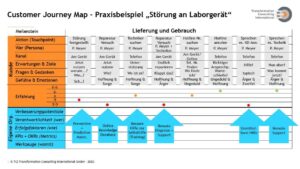
This step breaks down the data,
- what options are available,
- who is responsible,
- what determines success,
- how success can be measured, and
- which tools may need to be used.
Now companies need to model the customer journey to their advantage: This is the starting point where they may begin to think from the inside out, defining the improvement measures that will achieve the best external impact. The factors and possible measures are shown in blue in the diagram below (Figure 4).
You need to determine which touchpoint is the best place to start. It is not always the point at which the customer has a bad experience. It often makes sense to start at the previous step in order to prevent the negative experience at the next touchpoint. Sometimes you also start at the next touchpoint because the negative experience at the previous step cannot be completely prevented.
The quality and thoroughness of your work in this part of customer journey mapping will determine the success of your improvements and the impact on the customer's experience during their journey with you. Before implementation, you should test all of these ideas with your customers by conducting a cost-benefit analysis. Only after positive feedback and an acceptable return on investment should implementation begin, the success and sustainability of which must of course also be reviewed.
Make the link to the Employee Experience (EX)!
CX and EX (employee experience) will grow increasingly interdependent. Companies will find that employees can and will only deliver to customer experiences that they have themselves. Company leaders must deliberately design and manage daily experiences that engage, empower, and equip their employees to differentiate and excel at CX.
~ Denise Lee Yohn, keynote speaker and author of FUSION: How Integrating Brand and Culture Powers the World's Greatest Companies.
Only with enthusiastic and loyal employees can customers be inspired and loyal customers be generated. In holistic experience management, it is therefore increasingly important not only to link customer experience and user experience, but also the link between customer experience and employee experience (EX). Because: Emotional experiences always a human being.
The connection between employee experience and customer experience is described by Denise Lee Yohn as the CX trend for 2020 seen. Bruce Tempkin, CCXP at Qualtrics, also describes the importance of people and employees in experience management very well in his LinkedIn post.
The following diagram (Figure 5) shows how we at TCI classify the employee experience (EX) in the overall context of holistic experience management (XM): In it, we place people at the center with Human Experience or Holistic Experience (HX):
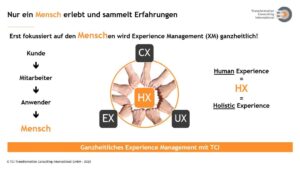
We will describe the topic of employee experience (EX) in detail, and in particular its importance for a consistent customer experience (CX), in a subsequent article.
Customer journey and moments of truth
Finally, we would like to point out the relationship between the customer journey mapping concept and the sales and marketing concept of "Moments of Truth". The idea of Moments of Truth was introduced by Jan Carlzon, the then CEO of Scandinavian Airways - SAS, in the 1980s and described in his book "The Moments of Truth". Jan Carlzon's concept is about adapting a customer-oriented business model that focuses on customer service and the points of contact between customers and the business.
In their Annual report for the year 2005 the then Chairman of Procter & Gamble, A.G. Lafley, gave this concept an additional focus to marketing and sales: starting with the decision for a product (first moment of truth) through the experience of use (second moment of truth) to feedback to the supplier (third moment of truth). This idea has Google 2011 expanded to include the search and selection step (zero moment of truth). The last moment of truth to date was developed in 2016 by customer service expert Shep Hyken as "new moment of truth in business" is defined as the "actual moment of truth" or "moment of truth gap". This moment describes the situation described in section d) Delivery & Use gap between order and arrival at the customer in online retail.
Do you notice anything? These "moments of truth" precisely map the milestones of the customer journey. The zero moment of truth corresponds to the phases Awareness and Consideration. The first moment of truth is the Decision. The phase Delivery & Use reflect the actual and the second moment of truth. In addition Use was already addressed by Jan Carlzon in the 1980s - with a focus on customer service excellence. The third moment of truth can be found in the customer journey milestone Advocacy & Loyalty again.
The continuous expansion of the moments of truth in the direction of a holistic omni-channel customer experience shows the relevance of customer journey modeling for every company that takes customer centricity seriously.
Use customer journey mapping correctly: Take advantage of your opportunities!
What do you think? Do you know all your customers' touchpoints? Do you know and fulfill their expectations? What are your customers' experiences at the touchpoints? At which milestone do many customers drop out? Do you know why they do this - and how you can change it?
If you think these are interesting questions that you would like to have answered, why not come along to one of our free 30-minute webinars? The webinars start regularly on Fridays at 15:00 or Mondays at 17:00. You can register for one of our next webinars here:
[su_spacer]
[su_button url="https://tci-partners.com/tci-online" target="blank" style="3d" background="#64696C" color="#F48D31″ size="8″ center="yes" icon="icon: hand-o-right" icon_color="#F48D31″]Click here for the free webinars[/su_button]
[su_spacer size="40″]
You are also welcome to take a look at our two-minute teaser for our webinars on. We look forward to welcoming you to our webinars!
[su_spacer size="40″]
(Cover image: © Quintanilla | shutterstock.com)

